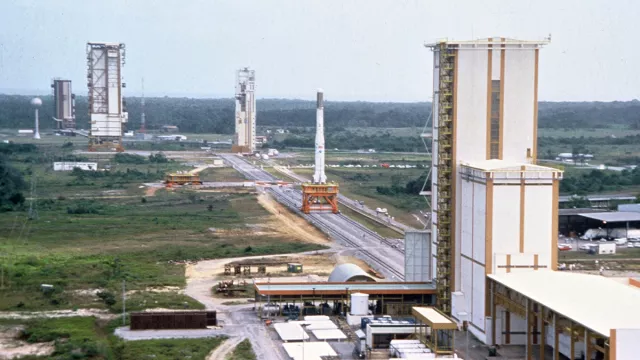Ever since its inception in the 1970s, the Ariane programme has constantly evolved to keep pace with the demands of the telecommunications satellite market. A new launcher, Ariane 6, is due to make its first flight from the Guiana Space Centre on 9 July 2024.
Key information
| Mission | Space transportation |
|---|---|
| Domain | Space transportation |
| First launch | Ariane 1: 24 December 1979 |
| Partners | ESA, Arianespace |
| Launch base | Guiana Space Centre |
| Service lifetime | 23 years |
| Status | Completed |
Key figures
- 11 Ariane 1 launches, 2 failures
- 6 Ariane 2 launches, 1 failure
- 11 Ariane 3 launches, 1 failure
- 116 Ariane 4 launches, 3 failures
Key milestones
- 15 February 2003: Last Ariane 4 flight
- 15 June 1988: First Ariane 4 flight
- 12 July 1989: Last Ariane 3 flight
- 4 August 1984: First Ariane 3 flight
- 2 April 1989: Last Ariane 2 flight
- 31 May 1986: First Ariane 2 flight
- 22 February 1986: Last Ariane 1 flight
- 24 December 1979: First Ariane 1 flight
- 31 July 1973: Ariane programme kick-off
Project in brief
Ariane 1, the first variant of Ariane, made its maiden flight from the Guiana Space Centre (CSG) on 24 December 1979. It was quickly replaced by more powerful variants—Ariane 2, Ariane 3 and Ariane 4—which made their first flights in 1986, 1984 and 1988.
The increased mass of satellites then made it necessary to go back to the drawing board. This resulted in the Ariane 5 variant, capable of placing up to 9.4 tonnes into geostationary transfer orbit (GTO). Following its first flight in 1996, Ariane 5 quickly became a world leader in the telecommunications satellite launch market.
But the dual-launch capacity that was for so long one of its strengths soon became something of a challenge in an increasingly competitive context. The market was changing, and Ariane’s engineering and business model had to adapt accordingly.
So, in 2014, Europe decided to breathe new life into Ariane, with the launch of the Ariane 6 programme. Designed by teams from CNES, the European Space Agency (ESA) and industry, Ariane 6 will be better adapted to the launch of government and commercial satellites, thanks to its two variants (Ariane 61 and Ariane 64), the ability to relight its upper stage, and managed production costs. Its first flight is scheduled from the CSG on 9 July 2024.
CNES’s role
Based initially on the work of CNES, the Ariane programme was launched by the European Space Agency (ESA) in 1973, to enable Europe to put its satellites into orbit without having to rely on the other space powers. It replaced the unsuccessful Europa programme, initiated in the 1960s.
Contacts
Head of Space Transportation Strategy
Philippe Pujes
E-mail: philippe.pujes at cnes.fr


